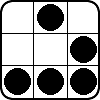It also seems to me like a depth test precision issue, what can be aid by projection matrix. But back to original issue of not running on ios.
You might check theese things that are prone to errors between less flexible operation systems:
- back buffer and off screen render targets formats, as well resolutions
- ios, I have never coded for, can demand some sort of " frame draw enclosing", since ogl misses explicit presentation call, it can be some begin/end pair of entire gpu calls
cannot think of some other things to check.
Thanks for the ideas. I tried changing the near and far plane distances, but to no effect. I also switched to using glutSwapBuffers(), to no effect.
I also tried glFrontFace(GL_CCW) on the Mac to no effect -- will try it on the Windows machine later tonight.





